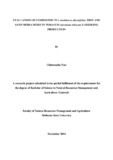Please use this identifier to cite or link to this item:
https://cris.library.msu.ac.zw//handle/11408/2539| Title: | Evaluation of composted tea (melaleuca alternifolia) tree and sand media mixes in tobacco (nicotiana tabucum l) seedling production | Authors: | Chimwanda, Noel | Keywords: | Floating tray system | Issue Date: | Nov-2014 | Publisher: | Midlands State University | Abstract: | Zimbabwe is preparing itself for 2015 dead line for the elimination of methyl bromide through adoption of floating tray system, metham sodium, basamid and other related tobacco nursery chemicals. In an effort to complement this government initiative to fulfil Montreal protocol, a research was carried out at Kushinga Phikelela National Farmer Training College, in Marondera during the 2014-2015 tobacco farming season with intention to evaluate the effect of an on farm composted tea tree and sand media mixes on performance of tobacco (Nicotiana tabucum) seedlings in a float bed system. This was being compared to the traditional pine bark media (control). A completely randomized design (CRD) with six treatments and three replications was used. The treatments were; 100% Pine bark, 100% Tea tree substrate, and tea tree growing mixes of 80:20, 70:30, 60:40 and 50:50 of composted tea tree to sand respectively. Composted tea tree was taken for full chemistry analysis before mixing with sand at Zimlab, Harare Zimbabwe. Results showed that composted tea tree substrate had a pH of 6.4. The sample results also showed presence of nitrogen 5.62 ppm, phosphorous (P2O5) 207.16, potassium 4.20 (% of CEC)/ppm and total exchangeable bases at 35.99 CEC. During the experiment, the following parameters were measured; seed emergence percentage, seedling height, stems thickness, spiral root development and leaf number. In was concluded that the treatments 70:30, 80:20 and 100% composted tea tree and sand media mixes were not significantly different to pine bark statistically on emergence percentage, stem height, spiral roots, and leaf numbers. A high fall out percentage of media from trays was experienced in 50:50 and 60:40 composted tea tree and sand media. 100% Pine bark recorded significantly (P<0.05) highest emergence percentage. There was no significance (P<0.05) difference on all other parameters between pine bark and 70:30, 80:20 and 100% composted tea tree and sand media mixes. There was no statistical difference between 50:50 and 60:40 composted tea tree and sand media mixes on emergence percentage, spiral root development, stem height, stem thickness, and leaf numbers; and these two recorded least results on all parameters. It was recommended that tobacco seedling production may be done using tea tree substrate at treatments 70:30, 80:20 and 100% composted tea tree and sand media mixes as alternative growing media to pine bark and may be economic if used at 70:30 composted tea tree and sand media mix. | URI: | http://hdl.handle.net/11408/2539 |
| Appears in Collections: | Bsc Natural Resources Management and Agriculture General Degree |
Files in This Item:
| File | Description | Size | Format | |
|---|---|---|---|---|
| NRM316 final dissertation.pdf | Full Text | 1.24 MB | Adobe PDF |  View/Open |
Page view(s)
152
checked on Feb 26, 2025
Download(s)
84
checked on Feb 26, 2025
Google ScholarTM
Check
Items in MSUIR are protected by copyright, with all rights reserved, unless otherwise indicated.


